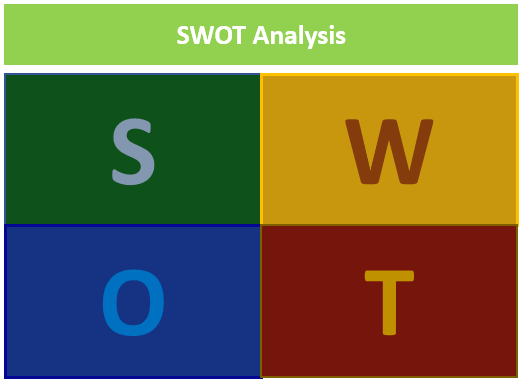In business, there are several tools that one may use to analyze the performance or other aspects of a company. However, there is one tool that is often preferred by most users because of how easy it is to prepare and understand. It is known as SWOT analysis, also referred to as corporate appraisal.
What is SWOT Analysis?

SWOT analysis is an analytical technique used to analyze the internal and external factors that impact a company. SWOT stands for Strengths, Weaknesses, Opportunities, and Threats. Each of these elements in the analysis plays a vital role and helps users evaluate a company. SWOT analysis is an integral part of the strategic analysis of a company.
A SWOT analysis helps users focus on both internal and external factors of a company, unlike other tools, which tend to focus on one aspect or the other. By performing a SWOT analysis, companies can reduce their chances of failure, by understanding in which departments they are lacking and eliminating any threats that can be problematic in the future.
Overall, a SWOT analysis helps companies develop a strategy that can allow them to achieve a competitive advantage by focusing on their strengths and eliminating their weaknesses. Similarly, it can help them achieve better results in the future by considering their opportunities and threats. To better understand what SWOT analysis is, it is vital to understand each of its four elements.
Strengths
Strengths represent all internal factors that a company does particularly well or those that give it a competitive advantage over others. These entail the leverage of a company over its competitors or in the market. Strengths can come from several aspects of a company, such as competent management, brand name, quality products, etc.
The strengths of a company are an integral part of its success. These are what help the company run its operations smoothly and ensure its customers its products over others in the market. To find its strengths, a company must ask what are the internal features that it possesses, while its competitors lack. Similarly, strengths can come from the major successes of a company.
For SWOT analysis, strengths only represent factors that a company has that its competitors don’t or the qualities that separate it from competitors. If a competitor also has similar qualities, regardless of how well the company is doing it, it does not make the company’s strengths, nor its competitor’s.
Weaknesses
Weaknesses are the opposite of strengths. Therefore, these represent internal factors that a company doesn’t do well or ones that give its competitors an advantage. These can come from processes or qualities that a company lacks. Similarly, weaknesses represent things that competitors do better than a company.
Weaknesses can come from various sources, similar to strengths. The most common reason for these weaknesses is a lack of resources, which limits a company’s functions. The reason why companies need to analyze their weaknesses is to correct them or improve them in order to either gain a competitive advantage or at least be equal to the competition.
Overall, weaknesses help companies identify things that are not doing or not doing well but should be. These can also come as a result of major failures, from which companies need to learn. Similarly, it needs to rectify any errors in the process. Likewise, weaknesses are negative factors that detract from a company’s strengths.
Opportunities
Opportunities are different from both strengths and weaknesses. While the above two elements focus on internal factors, opportunities represent external factors. Opportunities are factors that show events or changes in the external environment of a company that it can exploit and convert into strengths. Opportunities may either come to a specific company or an industry as a whole. Therefore, companies need to utilize them or lose the advantage promptly.
Opportunities can also come from things that are likely to go well in the future. Opportunities can come from several sources, for instance, new market segment opening, decrease in competition, positive press promotions, emerging markets, increase in demand, and many more. By exploiting these factors, companies can increase their sales and grow.
Opportunities may take a long time to realize, though. Similarly, these come once in a while. Therefore, companies need to survey their external environments regularly to identify these and act on them promptly. As mentioned, competitors may have the same opportunities as a company. Therefore, the company must take a competitive advantage by taking advantage of them first.
Threats
Threats are also external factors that present to a company. However, unlike opportunities, these can negatively impact a company. Threats come as a result of events or changes in the external environment that companies need to protect themselves against or defend themselves. These are things that are likely to go badly in the future.
Threats are the opposite of opportunities and, therefore, come from similar sources. Some threats that companies may face include an increase in competition, changes in laws and regulations, negative press coverage, changes in demand or customer attitude, and much more. Like opportunities, companies need to identify these threats promptly or face many problems in the future.
Threats can cause heavy damage to a company if it does not identify them and act against them. Companies can eliminate the threats that face them in some cases. In other cases, eliminating them may not be an option. Therefore, companies may need to take preventative measures to minimize their impact.
Why is the SWOT Analysis important?
There are several reasons why companies need to perform SWOT analysis that add to its importance. Firstly, it helps companies evaluate where they stand in terms of competition and what they need to do the improve their competitive advantage. Therefore, it can help in the decision-making and planning processes of a company.
SWOT analysis also helps companies get visibility on their current status and allows them to measure their performance. Similarly, its four elements all represent factors that companies either need to improve or act on or face problems in the future. Overall, it can help them penetrate the market better and take over the competition.
Overall, SWOT analysis allows companies to identify external and internal factors through their strengths, weaknesses, opportunities, and threats that can impact their business positively or negatively. It can also help them in developing a proactive strategy in order to take appropriate actions at the right time. Lastly, it gives better insights into the processes of a company and its future aspects.
When should companies perform a SWOT analysis?
SWOT analysis is a useful tool that companies can use at any time. Usually, it is best to perform a SWOT analysis before taking new actions or making new plans. For example, if a company wants to expand into new markets or develop new products, it must perform a SWOT analysis. It helps the company to get a better picture of where it stands and how its decisions can help gain a competitive advantage.
SWOT analysis can also be a great tool for companies to analyze their current position or situation. Therefore, some companies may prepare the analysis regularly to examine how their position has changed or what future prospects exist. It can also be useful in identifying any deficiencies in processes or operations and correcting them promptly.
When performing a SWOT analysis, it is best to consider all aspects of a company, regardless of when companies prepare it. That is because all the elements of the SWOT analysis combined give a better view of the company’s performance. In short words, it shows a whole picture of the company’s operations and position, which allows for better decision-making and planning.
Conclusion
SWOT (Strengths, Weaknesses, Opportunities, and Threats) analysis is a tool often used in businesses to determine the internal and external factors that affect a company. Strengths are internal factors that give companies a competitive advantage, while weaknesses are the opposite. Similarly, opportunities are external factors that a company can exploit to convert into a strength, while threats show problems that a company may face in the future.



